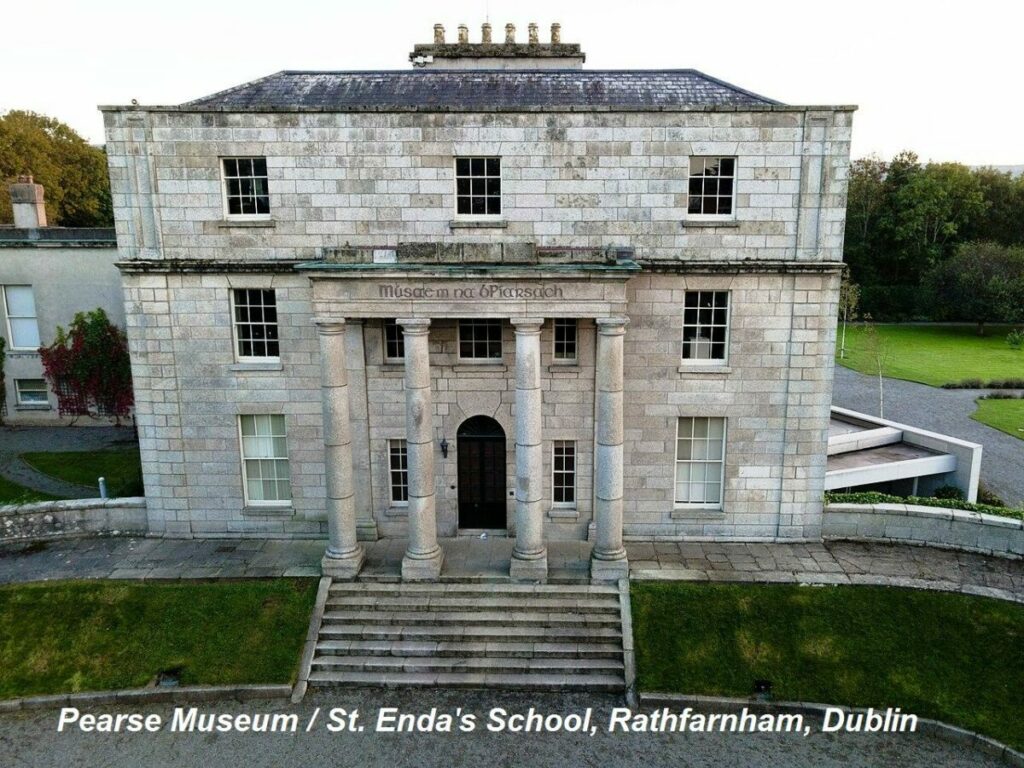
By Mike Finn
Margaret Brady was born on February 12, 1857 in Dublin. Her father was Patrick Brady, a coal merchant, whose family was from County Meath, and her mother was Brigid (Savage) Brady of Oldtown, County Dublin. Margaret was educated by the Sisters of St. Vincent de Paul.
James Pearse was born in Bloomsbury, England, and later lived in Birmingham. He moved to Dublin about 1863 to work as a stonemason and carver. He opened a business and met Margaret, who was working as a stationery shop assistant. In 1877 Margaret married James Pearse at St. Agatha’s church in Dublin.
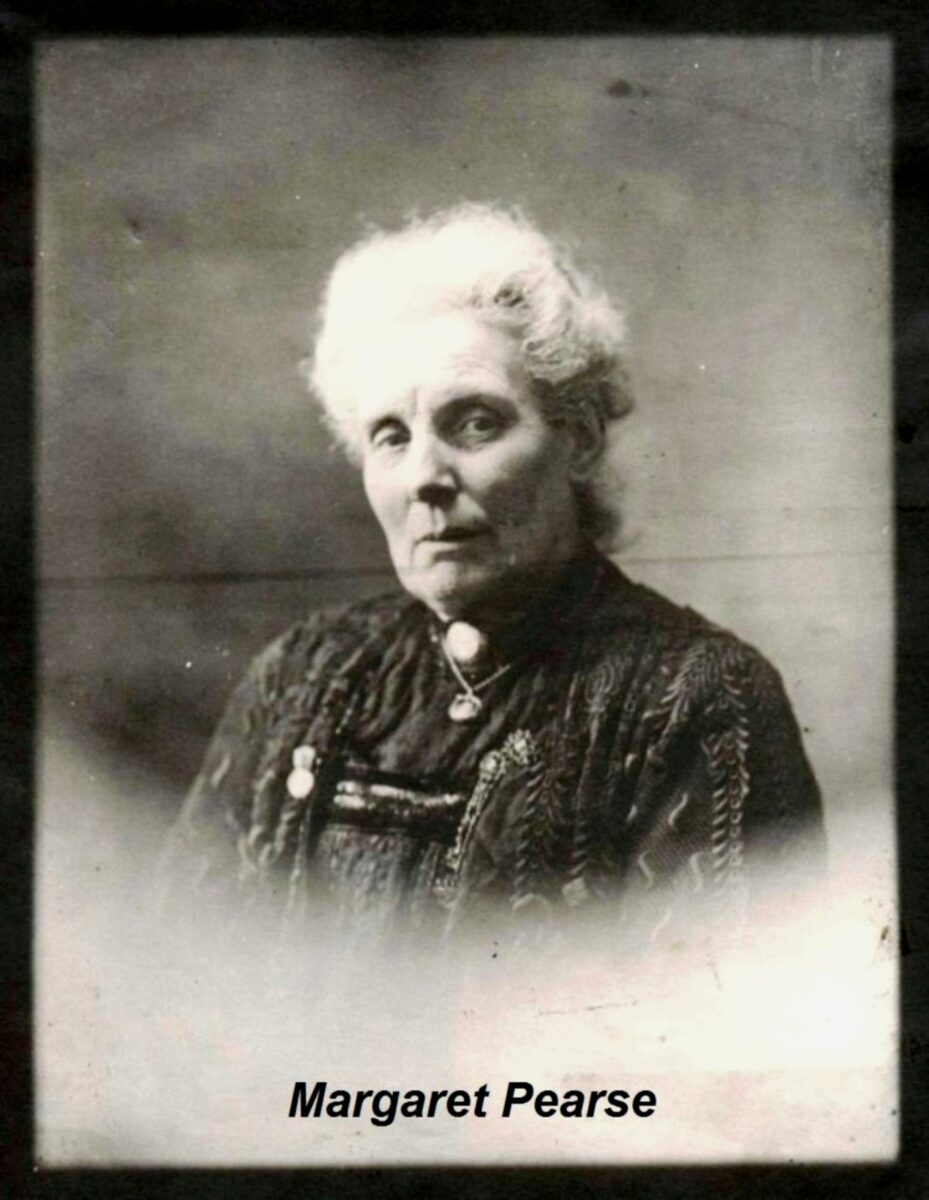
James and Margaret had four children. These were Margaret Mary, born August 4, 1878; Patrick, born November 10, 1879; William (Willie), born November 15, 1881; and Mary Brigid, born September 29, 1888.
Margaret’s maternal aunt, Margaret Savage, was an avid Irish speaker and was a frequent visitor to the Pearse home. She encouraged the Pearse children’s interest in the Irish language and culture.
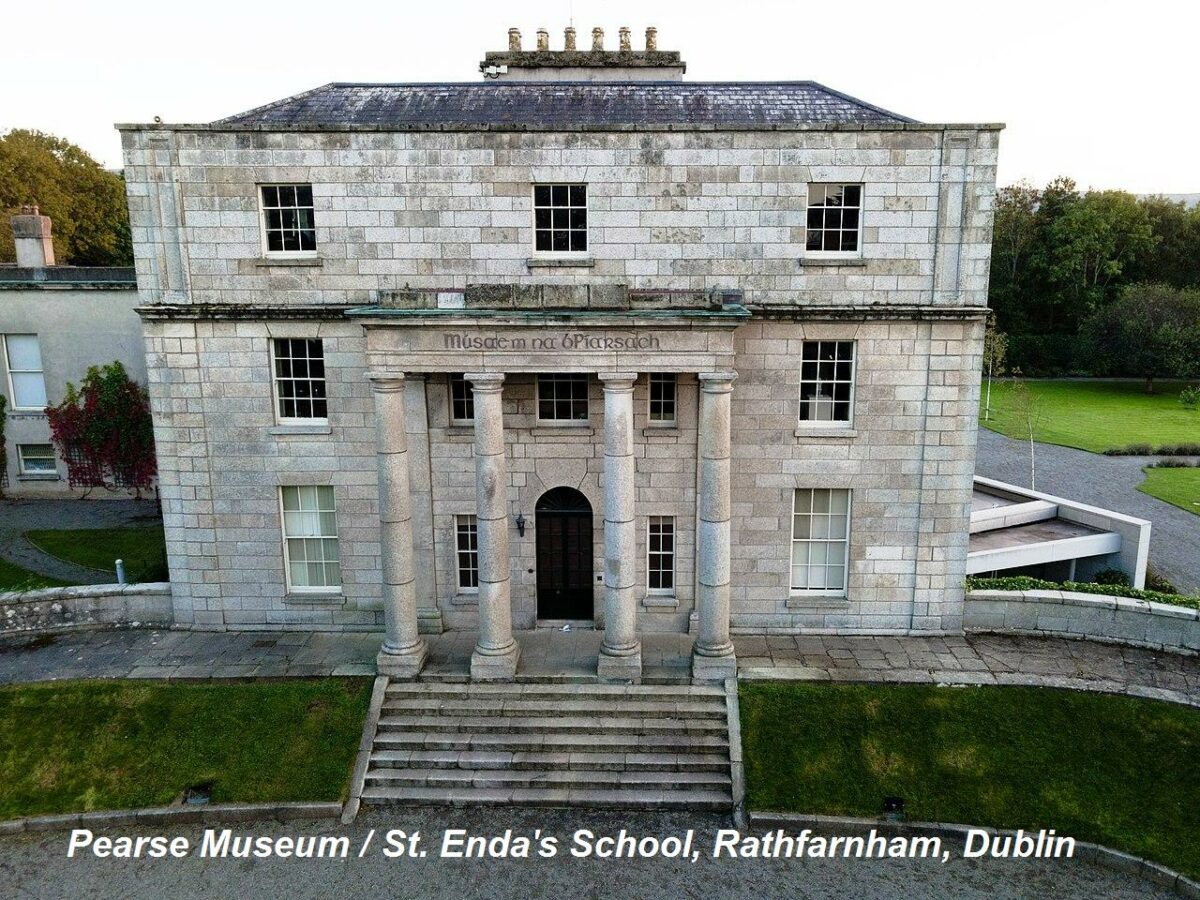
In September 1908, using his life savings and some borrowed funds, Margaret’s son Patrick Pearse founded St. Enda’s School for boys (St. Enda is the patron saint of the Aran Islands).
Originally, Pearse’s school was established at Cullenswood House, Ranelagh, before moving to the Hermitage in Rathfarnham in 1910.
To advance his ideas of a free and Gaelic Ireland, the school offered a bilingual education that placed emphasis on Irish literature, Irish culture and Irish mythology. Pearse believed that the Irish language was intrinsic to the identity of a nation.
Ireland’s first bi-lingual school was a family operation, as his mother Margaret initially took over housekeeping duties at the school. Brother Willie taught there as an art and theater professor and later served as Assistant Head Master. His sister Margaret Mary also served as a French professor and later Mistress of Students.
In 1913, Patrick became Director of Organization for the Irish Volunteers. In December 1913 Bulmer Hobson swore Pearse into the secret Irish Republican Brotherhood (IRB). Patrick’s brother Willie followed him into the Volunteers. Patrick was soon taken onto the IRB’s Supreme Council by Tom Clarke.
Aware of her sons’ intentions, Margaret fully supported them as they left St Enda’s on Easter Monday 1916 and marched to the GPO to begin the Easter Rebellion. As a result of the rebellion, Patrick Pearse and fourteen other leaders, including his brother Willie, were court-martialed and executed by firing squad for their participation.
While Patrick was awaiting execution in Kilmainham Jail, he wrote a poem for his mother, titled The Mother. It is about a mother than raises her two boys, but they die fighting for Irish independence. It concluded with the following words:
Lord, thou art hard on mothers:
We suffer in their coming and their going;
And tho’ I grudge them not, I weary, weary
Of the long sorrow – And yet I have my joy:
My sons were faithful, and they fought.
Following the execution of her two sons, Margaret adopted the republican cause and saw it as her purpose to perpetuate their memory.
Margaret joined Sinn Féin after the 1916 Rising and gave support and endorsement to candidates during the 1918 Westminster Election. During the 1920 Poor Law Elections for the Rathmines area of Dublin, Margaret ran as a Sinn Féin candidate and was elected on the first count. In the 1921 elections, she was elected to the second Dáil Éireann as a Sinn Féin legislator for Dublin County.
In the Dáil, Margaret strongly opposed the Anglo-Irish Treaty. She stated during the Treaty debate that: “It has been said here on several occasions that Patrick Pearse would have accepted this Treaty. I deny it. As his mother I deny it, and on his account I will not accept it.”
When the Dáil ratified the treaty on January 7, 1922, Margaret, along with Éamon de Valera, the other anti-Treaty republican members walked out. She became close friends with Éamon de Valera as a result. She ran again for the Dáil in the 1922 general election, but was defeated.
Despite her electoral defeat, there was much work to be done at St. Enda’s. Operating funds were scarce and Margaret became St. Enda’s school’s chief fund raiser. She envisaged St Enda’s as Patrick and Willie’s lasting monument. With the help of American aid she had been able to buy the Hermitage property in 1920.
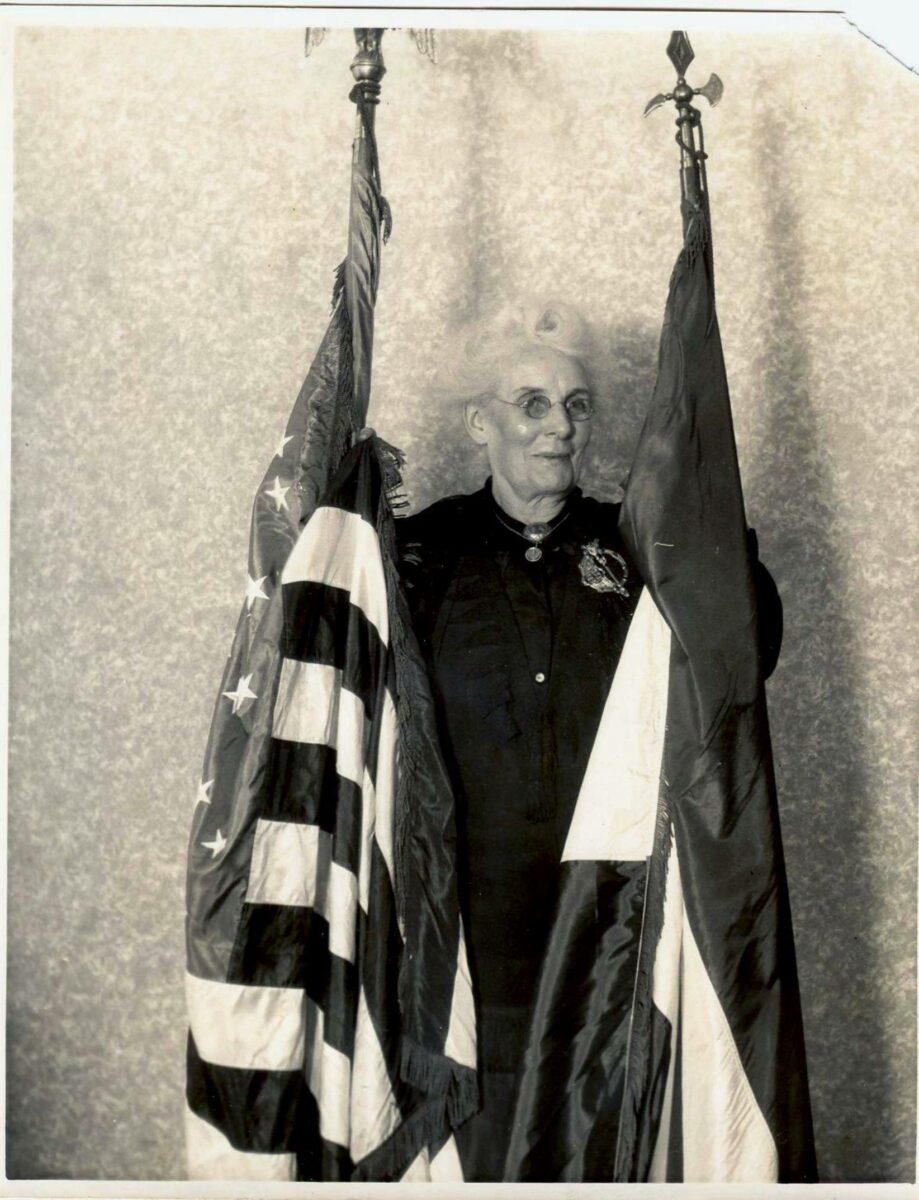
In April 1924, when Margaret Pearse was age 70, she undertook a trip to America to raise funds for the school, as well as showing support for Éamon de Valera and the Irish Republic and opposing the Anglo-Irish Treaty.
At an event in Brooklyn on May 19, 1924, when referencing the execution of her two sons, Margaret declared herself the “proudest mother in Ireland.” She was greeted by large crowds at her speeches.
The press gave her positive reviews and referred to her as the “most glorious of Irish mothers.” A testimonial dinner was held for her in Philadelphia on June 5, 1924.
In her speeches, she spoke of the death of her two sons and the financial difficulties of St. Enda’s. She also spoke harshly of the establishment of the Irish Free State. She referred to it as a “farce” and “a slave state¬.”
Margaret travelled to New York, Massachusetts, Pennsylvania and Ohio (Cincinnati and Cleveland). She then went west across the country, speaking to crowds in Montana, Washington, and California.
Speaking in Butte, Montana, Margaret summed up her task of taking responsibility for the school by stating, “It is a tradition with us that when our men folk are wrested from us, the women step in to fill the gap and carry on.”
Her tour of America raised $10,000 to support St. Enda’s School and she collected some promises for further support.
Margaret Pearse died on April 22, 1932 at St Enda’s. She was accorded a state funeral, and her body lay in state at City Hall before burial at Glasnevin Cemetery. Her funeral was one of the largest in the history of the Irish state. Éamon de Valera’s graveside oration was broadcast on radio.
Without the leadership and the fund raising abilities of Margaret, St. Enda’s School could not last and it eventually closed its doors for good in 1935. Today the Hermitage is owned by the state and stands as the Pearse Museum, dedicated to the memory of the school’s founders; exactly as Margaret Pearse would have wanted it.
Find this and other columns from the January 2023 issue here!





*J. Michael Finn is the Ohio State Historian for the Ancient Order of Hibernians and Division Historian for the Patrick Pearse Division in Columbus, Ohio. He is also past Chairman and Life Member of the Catholic Record Society for the Diocese of Columbus, Ohio. He writes on Irish and Irish-American history; Ohio history and Ohio Catholic history. You may contact him at [email protected]
ends
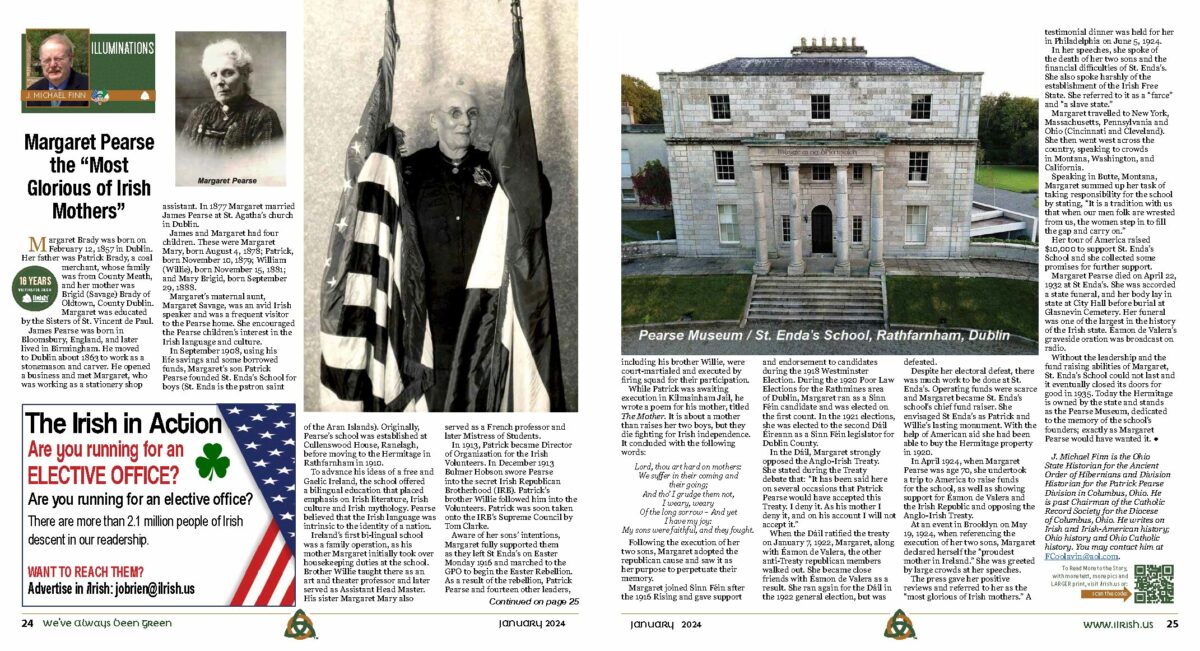

Monthly newsmagazine serving people of Irish descent from Cleveland to Clearwater. We cover the movers, shakers & music makers each and every month.
Since our 2006 inception, iIrish has donated more than $376,000 to local and national charities.
GET UPDATES ON THE SERIOUS & THE SHENANIGANS!